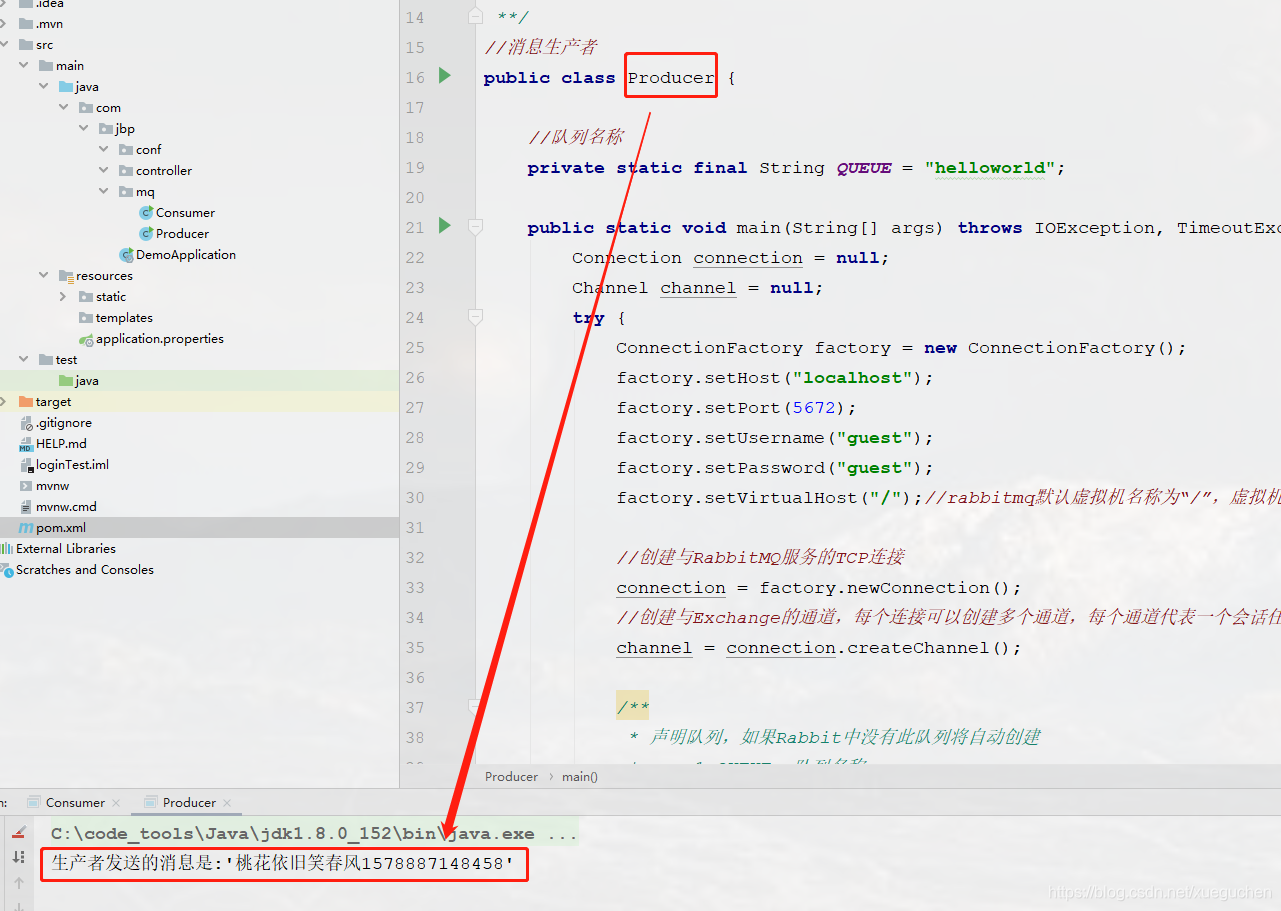RabbitMQ小结(五)java整合之简单模式
简单模式架构图

1.环境

2.生产者
package com.jbp.mq;
import com.rabbitmq.client.Channel;
import com.rabbitmq.client.Connection;
import com.rabbitmq.client.ConnectionFactory;
import java.io.IOException;
import java.util.concurrent.TimeoutException;
/**
* @Author JiangBeiPing
* @Date 2020/1/13 9:44
* @Version 1.0
**/
//消息生产者
public class Producer {
//队列名称
private static final String QUEUE = "helloworld";
public static void main(String[] args) throws IOException, TimeoutException {
Connection connection = null;
Channel channel = null;
try {
ConnectionFactory factory = new ConnectionFactory();
factory.setHost("localhost");
factory.setPort(5672);
factory.setUsername("guest");
factory.setPassword("guest");
factory.setVirtualHost("/");//rabbitmq默认虚拟机名称为“/”,虚拟机相当于一个独立的mq服务器
//创建与RabbitMQ服务的TCP连接
connection = factory.newConnection();
//创建与Exchange的通道,每个连接可以创建多个通道,每个通道代表一个会话任务
channel = connection.createChannel();
/**
* 声明队列,如果Rabbit中没有此队列将自动创建
*param1:QUEUE 队列名称
*param2: true 是否持久化
*param3: false 队列是否独占此连接
*param4: false 队列不再使用时是否自动删除此队列
*param5: null 队列参数
*/
channel.queueDeclare(QUEUE,true,false,false,null);
String message = "桃花依旧笑春风"+System.currentTimeMillis();
/**
* 消息发布方法
* param1: "" Exchange的名称,如果没有指定,则使用Default Exchange
* param2: QUEUE routingKey,消息的路由Key,是用于Exchange(交换机)将消息转发到指定的消息队列
* param3: null 消息包含的属性
* param4:message.getBytes() 消息体
* ---------------------------------------
* 这里没有指定交换机,消息将发送给默认交换机,每个队列也会绑定那个默认的交换机,但是不能显示绑定或解除绑定
* 默认的交换机,routingKey等于队列名称
*/
channel.basicPublish("",QUEUE,null,message.getBytes());
System.out.println("Send Message is:'" + message + "'");
}catch (Exception ex){
ex.printStackTrace();
}finally {
if(channel != null){
channel.close();
}
if(connection != null){
connection.close();
}
}
}
}
3.消费者
package com.jbp.mq;
import com.rabbitmq.client.*;
import java.io.IOException;
import java.util.concurrent.TimeoutException;
/**
* @Author JiangBeiPing
* @Date 2020/1/13 10:19
* @Version 1.0
**/
public class Consumer {
private static final String QUEUE = "helloworld";
public static void main(String[] args) throws IOException, TimeoutException {
ConnectionFactory factory = new ConnectionFactory();
//设置RabbitMQ所在服务器的ip和端口
factory.setHost("127.0.0.1");
factory.setPort(5672);
Connection connection = factory.newConnection();
Channel channel = connection.createChannel();
//声明队列
channel.queueDeclare(QUEUE, true, false, false, null);
//定义消费方法
DefaultConsumer consumer = new DefaultConsumer(channel) {
/**
* 消费者接收消息调用此方法
* @param consumerTag 消费者的标签,在channel.basicConsume()去指定
* @param envelope 消息包的内容,可从中获取消息id,消息routingkey,交换机,消息和重传标志 (收到消息失败后是否需要重新发送)
* @param properties
* @param body
* @throws IOException
*/
@Override
public void handleDelivery(String consumerTag, Envelope envelope, AMQP.BasicProperties properties, byte[] body) throws IOException {
//交换机
String exchange = envelope.getExchange();
//路由key
String routingKey = envelope.getRoutingKey();
//消息id
long deliveryTag = envelope.getDeliveryTag();
//消息内容
String msg = new String(body, "utf-8");
System.out.println("receive message.." + msg);
}
};
/**
* 监听队列String queue, boolean autoAck,Consumer callback
* @param : QUEUE 队列名称
* @param : true 是否自动回复,设置为true为表示消息接收到自动向mq回复接收到了,mq接收到回复会删除消息,设置为false则需要手动回复
* @param : consumer 消费消息的方法,消费者接收到消息后调用此方法
*/
channel.basicConsume(QUEUE,true,consumer);
}
}
4.测试


5.流程总结
- 发送端操作流程
1)创建连接
2)创建通道
3)声明队列
4)发送消息 - 接收端操作流程
1)创建连接
2)创建通道
3)声明队列
4)监听队列
5)接收消息
6)ack回复
